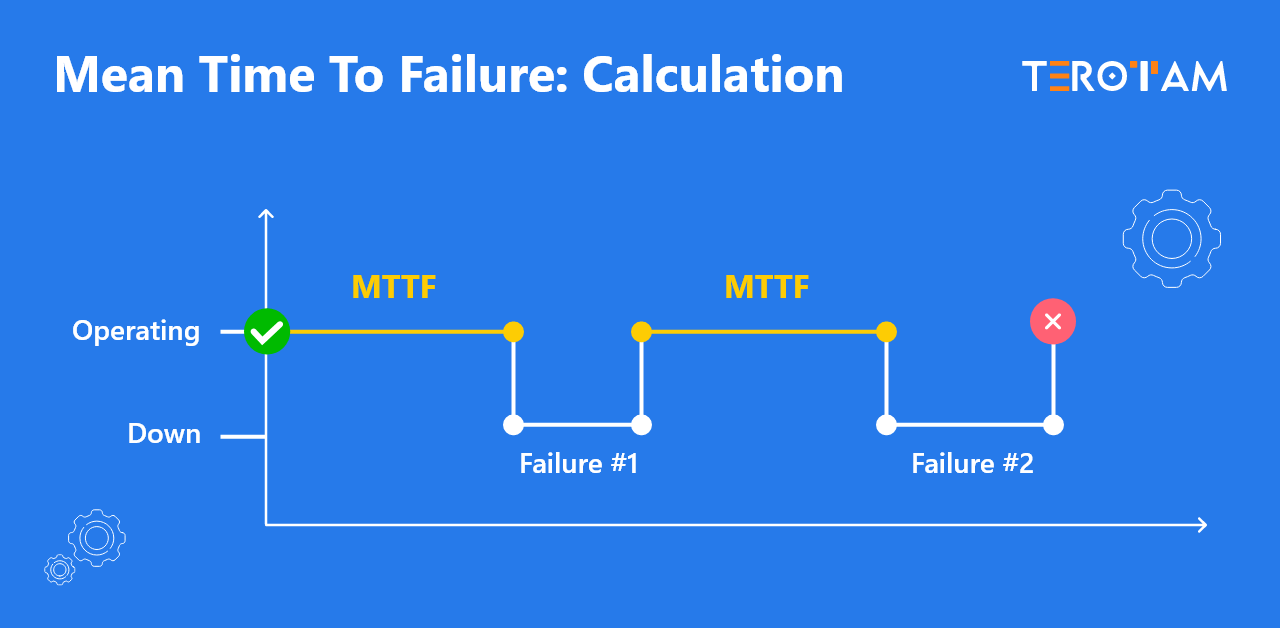Reliability is a paramount consideration in the realm of engineering and technology, with businesses and industries constantly striving to enhance the dependability of their products and systems. At the heart of this pursuit lies the crucial metric known as Mean Time to Failure (MTTF). MTTF provides a quantifiable measure of a system or component’s anticipated operational lifespan before succumbing to failure, making it an indispensable tool for engineers, manufacturers, and maintenance professionals.
This post will go over the details of Mean Time To Failures (MTTF), including its importance, how it’s calculated, and how using it may greatly increase production and dependability in a variety of industries. Our goal as we explore the field of reliability engineering is to simplify MTTF and enable companies to make wise judgements that positively impact their products and operations.
What is MTTF?
Mean Time to Failure (MTTF) is a reliability metric that represents the average time a system, component, or device is expected to operate before experiencing a failure. It is an essential parameter for evaluating the dependability of products and systems, providing insights into their longevity and performance over time.
MTTF vs MTBF: What’s the Difference?
While Mean Time To Failure (MTTF) and Mean Time Between Failures (MTBF) are related reliability metrics, they have distinct differences:
MTTF:
Focuses on the time to the first failure and is more commonly used for non-repairable systems or components.
MTBF:
Represents the average time between failures in repairable systems, accounting for both downtime and repair time.
How to Calculate MTTF?
The calculation of MTTF involves collecting data on the total operating time and the number of failures experienced by a system.
The formula for MTTF is as follows:
MTTF = Total Operating Time / Number of Failures
Steps to Calculate MTTF:
- Define the Time Period: Determine the time period over which you want to calculate MTTF. This could be hours, days, months, or any other relevant unit of time.
- Record Operating Time: Keep track of the total operating time of the system during the defined period.
- Count Failures: Record the number of failures that occurred during the specified time period.
- Apply the Formula: Use the formula mentioned above to calculate MTTF.
Example of MTTF Calculation:
Consider a fleet of industrial pumps operating continuously for 500 hours. Over this period, three pumps failed. To calculate the MTTF for these pumps, follow these steps:
Define the Time Period:
Time period (t) = 500 hours.
Record Operating Time:
Total operating time = 500 hours.
Count Failures:
Number of failures (N) = 3 pumps.
Apply the Formula:
MTTF = Total Operating Time / Number of Failures
MTTF = 500 hours / 3 Failures
MTTF ≈ 166.67 hours per failure
So, in this example, the Mean Time To Failure for the industrial pumps is approximately 166.67 hours per failure.
This calculated MTTF provides a valuable metric to assess the reliability of the pumps, indicating the average operating time before experiencing a failure. This information can be used to plan maintenance schedules, predict future performance, and optimize the overall reliability of the pump system.
Why is MTTF Important?
Reliability Assessment: MTTF quantifies the average time a system operates before its first failure, aiding in reliability assessments.
Maintenance Planning: Helps plan preventive maintenance by predicting when failures might occur, minimizing downtime.
Cost Efficiency: Informs decisions on component choices and system design to enhance durability, reducing long-term maintenance costs.
Product Performance: Provides insights into product performance, guiding improvements for better customer satisfaction.
Risk Management: Enables a more accurate evaluation of reliability-related risks, influencing warranty policies and customer trust.
Practical Implementation and Usability of MTTF for Better Productivity
Adding Mean Time To Failure (MTTF) to real-world scenarios involves a practical approach that enhances system reliability, maintenance planning, and overall productivity.
1. Predictive Maintenance:
Implementation: Utilize sensor data and monitoring tools to collect information on system health continuously.
Usability: Predictive algorithms analyze data trends, triggering maintenance actions just before expected failures, minimizing unexpected downtime.
2. Optimized Design:
Implementation: Conduct thorough reliability analysis during the design phase, considering component MTTF values.
Usability: Engineers select materials and components with higher MTTF, contributing to a more robust and durable system design.
3. Risk Assessment:
Implementation: Gather historical failure data and calculate MTTF regularly.
Usability: Evaluate risks associated with potential failures, guiding decisions on warranty policies, and building customer confidence.
4. Continuous Improvement:
Implementation: Establish feedback loops for continuous monitoring and data analysis.
Usability: Regularly update designs and maintenance strategies based on evolving MTTF insights, ensuring ongoing improvements in product performance and reliability.
5. Integration with Maintenance Systems:
Implementation: Integrate MTTF data into existing maintenance management software systems.
Usability: Enable maintenance teams to schedule proactive interventions, optimizing resource allocation and minimizing operational disruptions.
Conclusion:
Mean Time To Failure (MTTF) becomes apparent not just as a statistic but also as a conductor directing the system dependability symphony. As we navigate the crescendos of risk assessment and constant improvement, MTTF acts as the conductor, leading us from the stable beats of predictive maintenance to the harmonious patterns of optimized designs. As we acknowledge the power of MTTF, let us remember that it is more than just a term; rather, let it serve as a silent guarantee of long-lasting systems and a gentle reminder that when it comes to reliability, accuracy is not so much a note as it is a masterful performance.








